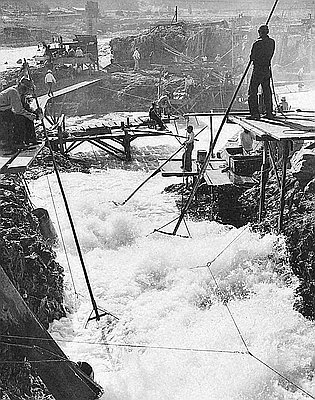This photograph, taken by The Dalles photographer Benjamin Gifford in 1897, shows an Indian man, possibly Wasco or Wishram, sitting in a dugout canoe in the vicinity of Celilo, Oregon. Many canoes like this plied the Columbia prior to white settlement, hauling goods and people up and down the river, which served as the transportation backbone of a vibrant regional trade network.
There were several different types of Native canoes in use on the Columbia River when whites first came to the region, though the shovelnose and Chinook types were most common. The one shown here is a shovelnose canoe, a medium-sized river craft characterized by a rounded prow and stern. Shovelnose canoes also had rounded bottoms to better manuever in swift river currents. The Chinook canoe, also known as the Nootka canoe, had a raised prow which was often decorated with carved figures. These well-crafted canoes, which ranged from fifteen to fifty feet in length, were used in both freshwater and saltwater.
Shovelnose and Chinook canoes were both dugouts, created by hollowing out a single log, usually western red cedar. Before the introduction of metal tools, this was accomplished through fire, steam, and the use of wood and stone tools. It was a slow process—good canoes could take many weeks to make and thus were highly valued.
Lewis and Clark were impressed both with the Chinookan people’s canoe-making skills and with their ability to navigate the crafts under the worst conditions. While the Corps of Discovery was weathering a storm near the mouth of the Columbia in November 1805, Captain William Clark noted a group of Chinookans who were casually riding the waves in a small canoe packed with salmon to trade on the coast. After speaking briefly with the stranded explorers, the Indian party headed across the estuary through what Clark described as “the highest Sees I ever Saw a Small vestle ride.” He referred to them as “Certainly the best Canoe navigaters I ever Saw.”
Further Reading:
Silverstein, Michael. “Chinookans of the Lower Columbia.” In Handbook of North American Indians: Northwest Coast, edited by Wayne Suttles. Washington, D.C., 1990.
Olson, Ronald L. “Adze, Canoe, and House Types of the Northwest Coast.” University of Washington Publications in Anthropology. Vol. 2, No. 1, 1927: 1-38.
Written by Cain Allen, © Oregon Historical Society, 2003.



